Synopsis
This study looks into the parameters of hats during the early parts of the 20th century. The existence of hats can be considered to be immemorial since humans have been using them for quite a long time. Initially humans used hide or skin for protecting their heads and even though that was not truly a hat, it started towards what we know as one. Formality and etiquette played a very important and significant role in the wearing of hats. At the dawn of the 20th century, people would wear their hats mainly based on their daily activities but some women who were concerned about their social status would change their hats a number of times during the day. People considered it to be bad manners and even disgraceful if one went out of their home without wearing their hats and gloves. Women were even reprimanded if they did not appropriately dress and wear their hats. During the beginning of the 1900s hats were considered to be a part and parcel of a person’s everyday wear. Along with being a significance of fashion and status, men and women also wore them simply to cover their heads or for warmth. Additionally, the study would reveal the socio-political approach of the time and its effects on hats.
Introduction
Hats have been worn both by men and women for centuries as a head covering, sometimes for protection, religious reasons or simply as a piece of fashion accessory. The differences in the styles of hats that have been seen during the first 2 decades of the 20th century are mainly in the styles relating to the crown, brim or peak of the hats worn. The crown is that portion of the hat which covers the top part of its wearer’s head. The brim is usually made of a stiff material and is sort of a projection horizontally covering the circumference of a hat. The peak is a projection that is placed in front of the hat.
Women and Hats
The turn of the century contributed the influence of the art nouveau to the women’s fashion world. Just like the skirts of the women whirled around their feet forming flower and fan like patterns, so did their hats which swept on their faces. Most of the hats had lavishly decorated brims which created the illusion that the hats were magically suspended on their heads. Apart from the enormous mass of the largely decorated hats, some even had long lacy veils which gave the onlookers the impression that the hat had a bubbly mass. Although worn by men and women alike, hats were more common and widespread among the women than the men and thus, came in a greater variety too. Of all the accessories that women used between 1900 and 1920, hats were the most diverse and spectacular ones. Throughout history, we have seen that women have had to cover their heads with wimples, hoods and veils but they started to wear hats only towards the end of the 16th century.
In the beginning of the 20th century, i.e. the Early Edwardian Period during 1901-1907, a hat became an indispensable element for a woman since fashion at that time demanded that the silhouette of a woman be like the S shape. Hats during this time were enormous in size and were usually decorated with lots of tulle, feathers, flowers and ribbons. Women used to wear them on the top of their stacked-up hair and it was positioned in such a way that it cantilevered right over their faces. These enormous hats complemented their curvaceous form of the body which was a little pouched around the waist ending in a long groomed skirt.
These heavily ornamented and large hats were matched with the dresses the women wore. Another popular form of the hat during this era was the toque and it became fashionable during the second decade on the 20th century. It was a brimless hat and became a favourite modest day wear for the women. It allowed women to participate in sports, like riding bicycle, playing golf and driving cars. Later in 1914, just before the First World War started, the toque hats were made very tall so that women could wear it with high-collared dresses. Other favourable hats of this era were section pancake berets with flat brims, boaters, panamas and felt homburgs.
In 1904 lingerie hats were also used which were usually ivory, white or cream in colour. The materials used to make them were either lace or muslin and were mainly used by those enjoying the warm summers. The colour of the hats that were worn by the men and women of this time also had significance since white mainly symbolized the wealthy people who had lines of maids. Similarly, these lingerie hats symbolized status and literally conveyed the message that the woman wearing it had enough wealth to afford another person to do her laundry. Between 1904 and 1907 a lot of attention was also given to the height of the hats worn by both men and women since their width decreased and height increased. These relatively small hats came with trimmings which were used to highlight height as an important feature of fashion in those days. These tall hats had a relatively narrow width too. As a women’s figure became more and more slender, the size of their hats started increasing.
After 1908 the Gainsborough chapeau became a widely used hat among the women. It had an extremely wide brim and was placed high on the hair. Its round brim extended even beyond the wearer’s shoulders and since it had a lot of feathers and ribbons, the hat looked wide and very tall. Another prominent women’s hat of this era was the Merry Widow hat and it was almost 18 inches tall and 3 feet wide with feathers and ribbons covering every bit of it. These hats were used for almost 3 years since they complimented the long columnar outfits worn by women those days. The hats were always black in colour and consisted of an organdie or chiffon encasing along with a lot of feathers. But as women started to use this style of hat while going to theatres, they started to block the view of others and thus, were ultimately banned in theatres. But after the First World War, big hats like these totally vanished.
After 1908 it was seen that women wore close-fitting dresses with huge hats that were even more ornamented than before. Women were very careful about the hats they wore and ensured that theirs was one of a kind. Felt was used as the fabric for making the modest hats which were stiff and had brims. Feathers and huge ribbons were used as ornamentations and they even continued beyond the wearer’s head. As women started to favour wider hairstyles, wide-brimmed hats became fashionable since they were able to balance their hairstyles. After the death of King Edward in 1910, large and wide black picture hats were also worn in order to mourn his death.
By 1911 it was seen that the hats had attained their largest form. Most of the time, the brim of the hats was extended, such that they reached further than the breadth of the shoulders of the wearer. The women thus, had to use hat pins in order to securely place the huge hats on their heads. Somewhere between 1911 and 1912, larger hats lost their favouritism. Women reserved the large picture hats only for certain occasions which required them to dress a lot. The smaller hats during this time consisted of spiky hussar plumes that were stiff and ostrich feathers. In 1913 the hats were then ornamented using 2 narrow feathers, known as Mephisto plumes, which were long, giving the hats a certain military value.
During World War I, the size of the hats started to gradually decease as did the size of women’s hairstyles and they began to wear their hats low. As the hats became plainer and plainer, people started to frown on hat decorations and feathers which earlier were considered to be fashionable. Even people’s character was judged by the hats they wore. Due to the onset of the war, if a woman wore a highly decorated large hat then people considered it to be unpatriotic since it was thought that they were more worried about their appearance rather than the effects of the war. Since 1916 women started to wear the cloche and soon it became their sole fashion. At the end of World War I the hat became a fashionable ideal for honouring a soldier’s widow or girlfriend. Women started to wear the hats down their head such that it seemed that they had dressed in their mother’s hats. Hats worn during this time also had a deeper crown which continued to get deeper till about the late 1920s after which the entire head was covered by the hat in a cloche manner. Brims of the hats became an optional entity as only summer hats were fitted with them. The cloche hat as first worn in 1908 and remained to be a fashionable hat till the 1930s.
After the First World War started, the hats worn by women stared to show a military influence. Also, after the war the hats which gained popularity included the postillion and the tricornes hats that were mainly worn by the war widows along with a black veil. A lot of sophisticated women also wore veils along with their hats and thus, veiled hats became a symbol of chic during this period. Those women who were adventurous preferred to wear hats which had wire frames and around them there used to be weaved strips of ribbons, lace, flowers, feather and various types of ornaments. Most women faced problems in wearing large hats as it cut short their activities. They were not able to make quick movements since the size of the hats became a hindrance. Automobiles were also widely used at this time and had open tops. Thus, women started to use hats with special coverings and veils so that their hair and faces could be protected from dust and wind.

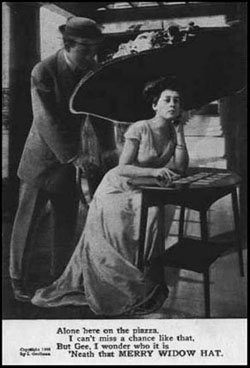

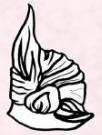
Men and Hats
From 1900- 1910, men wore a number of different types of hats and they could wear their hats for almost every occasion. In order to be considered as a gentleman, every man had to wear hats and could not be seen without them. Hats were strongly favoured both by men and women alike and it became their cultural tradition. Men’s headwear during the first half of the 20th century had 2 basic forms ─ the cap and hat. Usually soft fabric was used for making the caps, like wool or tweed and even other fabrics. They were normally brimless and were designed close to the crown. Men favoured wearing caps when they would perform outdoor activities, like riding their bikes and motoring. The hats during this time were almost always made of stiff materials that were also very heavy. The main materials used were straw and felt and the hats had an easily distinguishable crown and brim which was delicately placed away from the top portion of the wearer’s head. Although the hats worn by the men came in a number of styles, the difference between them was in the shape and size of the crown and brim. Also, the colour of the hats and materials used differed.
The Derby or Bowler hats were the most popular hats at the beginning of the 20th century and continued to be so till the First World War. It had a round crown and was made of wither brown or black felt. It had a reasonable height and at all times the brim of the hat would be curled up. Men wore the derby hats for almost all occasions and even the formal ones. Felt hats, like the fedora and homburg, were also very popular during this time since they were multipurpose hats. The homburg had a curled brim and was considered to be fairly formal. It also had an indent which ran all along the length of the hat’s crown. On the other hand, the fedora was considered to be the flamboyant hat since the wearer could easily snap the brim up or down and it also had multiple indents running along the crown instead of one. Due to this, the fedora was also called the “Snap brim” hat.
Another favourite hat worn during this time was the top hat which was mainly used in formal occasions. Black silk was used to make top hats and they had a very flat brim. It had a straight edged crown and was taller than the others. Some of these silk top hats were also collapsible. The Panama hat which had a wide brim was considered a specialized hat since it was mainly worn during the summer months. They were straw hats which were extremely stiff and had a very high crown. The sailor hat was also used which was a variation of the Panama hat, but it had a cylindrical crown that was flat and low and also had a wider brim. All of these hats were available in a wide range of colours and men would always match their hats to the occasion they dressed for and outfit they wore. These hats remained in fashion till the starting of the First World War and were worn by the young and old alike.
After the First World War, the above-discussed hats started to fade away and hats with new styles, which were built up on the old ones, came into view. The formal frock coats that were earlier worn by men were slowly replaced by lounge suits and just like their clothes, their hat styles would also change. By the late 1920s, the informal hat came into view and started to dominate men’s fashion. Although top hats and Panama hats were used by many, they were mainly reserved for more formal and special occasions. The most favoured hats of this time became the Boater hats which instantly gained popularity. It was usually made of straw with a red or navy ribbon. The newly emerged middle class favoured this hat very much.
After the First World War people favoured semiformal hats since they dressed as if they were on a vacation all the time. The straw boaters along with tweed and linen sports hats were worn by almost everyone. Also, after the First World War, the trilby, which had first been introduced in the 19th century, was reintroduced since men now favoured light and comfortable hats. Life had become very fast for the men and the trilby fitted properly with the new world. It had a wide brim and a pointy top and gained extreme popularity. Other types of hats that were worn by the men during the late 1920s included the Borsalino hat, Guerra Italian hat and Milano hat.
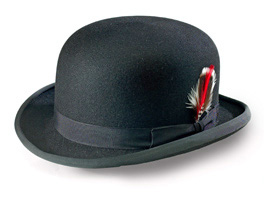
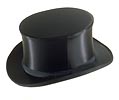
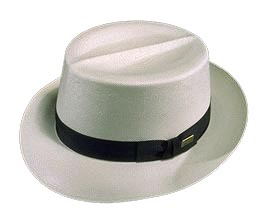

Conclusion
During the first part of the 20th century, and mainly in the Edwardian Period, it barely mattered, whether the wearer was rich or poor, a child or an adult. Regardless of the status of a person, hats were worn by all except the beggars. But that began to change after the First World War when slowly the hats became sort of a status symbol. The varied changes in the hat styles of men and women during the first half of the 19th century has greatly impacted the fashion world of the societies in London, Paris and New York. Hats have always signified and indicated the differences in the social statuses of these societies. Initially, hats were used by men and women alike simply as a means of covering their heads for safety and protection from injuries, like during wars.
But the changes in the styles slowly started to signify the authority and symbol possessed by the upper-class people of fashionable societies, like the ones that existed in London, Paris and New York. From being a mere uniform the impact of hats were such that they became a modern art form worn only by the fashion-savvy people. Hats made people noticeable by drawing the attention of the onlookers onto the face of the wearer. It was a simple piece of clothing that became a necessity for anyone and everyone who wanted to get noticed in the fashionable cities of the world, mainly London, Paris and New York. Hats were among those commodities which formed the basis of fashion exports and communication between the cities of London, Paris and New York. But due to the First World War, they had all dried up. Due to this, each city came up with its own design of hats which, even though were based on the older forms, had a little bit of uniqueness in their own.
After the 1920s hats slowly faded out of fashion but did not become obsolete. They were reserved more for worship and wedding occasions since they added more sophistication to a person’s appearance. The decades between 1900 and 1920 saw hats cover a journey from being a mere accessory to something that was considered as a functional item. However as the size of the hats became smaller and easily affordable by all, a drop in its symbolism was noticed. Sometimes, certain smaller varieties of hats were even banned from special venues since people associated them with the poor.
Bibliography
Edwards, T. (1997) Men in the mirror: men’s fashion, masculinity and consumer society. Virginia: Cassell.
Ginsburg, M. (1990) The hat: trends and traditions. NY: Barron’s.
Gower, R. (1991) “The Art of Headwear: A Century Ago“. Los Angeles Times 19 Mar: A3.
Harben, B. (2008) ‘Attitude towards fashion advertisements with political content: impacts of opinion leadership and perception of advertisement message’, International Journal of Consumer Studies, vol. 32, no. 1, pp. 88-98.
Lauer, JC. (1981) Fashion power: the meaning of fashion in American society. California: Prentice-Hall.
MacGillivray, M. (1998) Fashion opinion leadership among working and non-working women’, International Journal of Consumer Studies, vol. 22, no. 4, pp. 199-207.
McDowell, C. (1992) Hats: status, style, and glamour. Michigan: Rizzoli.
Paulicelli, E. (2006) Fashion, the Politics of Style and National Identity in Pre Fascist and Fascist Italy’, Gender & History, vol. 14, no. 3, pp. 537-559.
Steele, Valerie. (2005) Encyclopedia of clothing and fashion. LA: Thomson.
Studak, C. (2004) ‘Fashion groups, gender, and boredom proneness’, International Journal of Consumer Studies, vol. 28, no. 1, pp. 66-74.
Tell, M. (1980) Race, sex, and fashion innovativeness: A replication’, Psychology and Marketing, vol. 6, no. 4, pp. 249-262.
Winakor, G. (2005) ‘Perceived Fashion Risk and Self-Esteem of Males and Females’, Family and Consumer Sciences Research Journal, vol. 9, no. 1, pp. 45-56.
Youngjoo, N. (2009) Fashion design styles recommended by consumers’ sensibility and emotion’, Human Factors and Ergonomics in Manufacturing, vol. 19, no. 2, pp. 158-167.
Illustrations
- Silk toque
- Merry Widow Hat
- Hats with Mephisto Feathers
- 1910 Toque Hats
- Bowler Hats or Stiff Hat
- Silk Top Hat
- Panama hats
- Boater hats